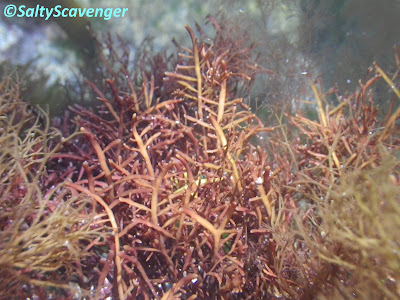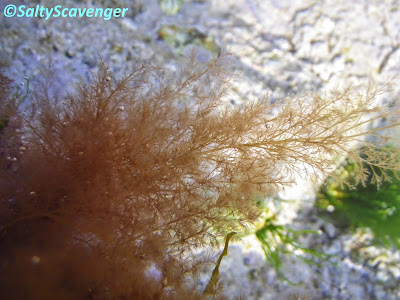The rocky shore is a high energy environment comprised of boulders and bedrock with rock pools, crevices and gullies.
 |
| he rocky shore is comprised of boulders and bedrock with rockpools, crevices and gullies. Habitat classification: LR.HLR (High energy littoral rock) EUNIS: A1.1 , LR.FLR.Rkp (Rockpools) EUNIS:A1.41 and LR.FLR.Lic.(Lichens on supralittoral and littoral fringe rock) EUNIS: B3.11. |
The high energy environment of the shore leads to an extended lichen zone, that descends over much of the boulder field, which apart from Littorinids is relatively barren. Patches of lichens extend further down into the barnacle communities, which dominate from the upper to lower shore, interdispersed by shallow coralline rockpools in the mid shore, and deeper cobble filled rockpools on the lower shore. As the low tide mark is reached wave tolerant seaweeds lace the gullies.
Habitat classification:
Substrate
|
LR (Littoral rock)
|
Habitat
|
LR.HLR (High energy littoral rock)
|
LR.FLR (Features of littoral rock)
|
Biotope complex
|
LR.HLR. MusB (Mussel and/or barnacle communities)
|
LR.FLR.Lic.(Lichens on supralittoral and littoral fringe rock).
|
LR.FLR.Rkp (Rockpools)
|
Biotope
|
|
LR.FLR.Lic.Ver (Verrucaria Maura on littoral fringe rock)
|
LR.FLR.Lic.YG (Yellow and grey lichens on supralittoral rock)
|
LR.FLR.Rkp.Cor (Coralline crust dominated shallow eulittoral rockpools)
|
SubBiotope
|
|
|
|
LR.FLR.Rkp.Cor.Bif (Bifurcaria bifurcata in shallow eulittoral rockpools)
|
Below are images of the organisms you may encounter in these habitats:
 |
Lichens characterise the supralittoral and littoral fringe with periwinkles among the boulders. The littoral fringe of the boulder field does not support vast expanses of tar lichen (Verrucaria maura) which covers more stable bedrock of the littoral fringe, however, the mobile species found among the boulders on the littoral fringe are consistent with that of the V. maura biotope. Habitat classification: LR.FLR.Lic.YG (Yellow and grey lichens on supralittoral rock) and LR (Littoral rock).
|
Examples of lichens found in the supralittoral:
 |
| Periwinkles are the most prolific mobile fauna of the boulder field, where they seek refuge within crevices. Rough periwinkles (Littorina compressa nigrolineata) and occasional barnacles. Habitat classification: A possible variant of LR.FLR.Lic.Ver (Verrucaria Maura on littoral fringe rock). |
 |
| Littorina saxatilis agg |
 |
| Littorina compressa var. nigrolineata |
 |
Bedrock on the mid shore support barnacle communities and coralline rockpools. Within the barnacle communities beadlet anemones and increased numbers of gastropods can be found within the crevices, whilst limpets aggregate on the leeward sides of the rock and Lichina pygmaea forms tufts on the rock tops.
Habitat classification: LR.HLR. MusB (Mussel and/or barnacle communities) EUNIS: A1.11 and LR.FLR.Rkp.Cor (Coralline crust dominated shallow eulittoral rockpools) EUNIS: A1.411. |
 |
| The lichen , Lichina pygmaea forms small bushy growths on the boulders, often supporting increased numbers of small periwinkles (Melarhaphe neritoides). In April the lichen appears somewhat greenish, by comparison to previously in the year. (See blog post http://thesaltyscavenger.blogspot.co.uk/2014/02/rockpooling-destination-west-penwith.html) |
 |
| A young crab feeds upon a M. neritoides |
 |
| Barnacles and limpets (Patella sp) |
 |
| Barnacles and M. neritoides |
 |
| As the lower shore is reached the abundance of barnacles and Patella depressa increases. |
 |
| The rockpools on this high energy shore are characterized by the presence of coralline seaweeds that make the rockpools appear as if they have been covered in a layer of pink paint. Habitat classification: LR.FLR.Rkp.Cor (Coralline crust dominated shallow eulittoral rockpools) EUNIS: A1.411. |
 |
| Brown seaweeds that were absent in October, now grow in the rockpools. (See blog post: http://thesaltyscavenger.blogspot.co.uk/2015/05/rockpooling-destination-revisit-south.html) |
 |
| China limpet (Patella ulyssiponensis) |
 |
| P. ulyssiponensis |
 |
| P. ulyssiponensis |
 |
| P. ulyssiponensis interacting. |
 |
| Common blue mussels (Mytilus edulis) and Corallina officinalis occur within a crevice of a coralline rockpool. |
 |
| A blenny and limpet. |
 |
| Deeper rockpools support a higher diversity of seaweed species including, a greater abundance of Corallina officinalis and the brown forking weed (Bifurcaria bifurcata). Habitat classification: LR.FLR.Rkp.Cor.Bif (Bifurcaria bifurcata in shallow eulittoral rockpools) EUNIS: A1.4113 |
 |
| The invasive Sargassum muticum |
Chondrus crispus
Chondrus crispus
 |
| Anemonia viridis |
 |
| Grey topshell (Gibbula cineraria) |














































































